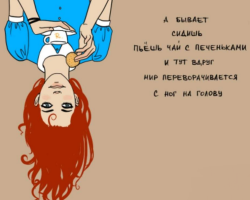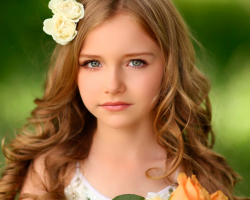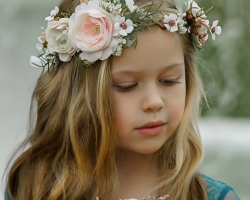Step -by -step instructions for drawing snowdrops.
Content
Try with your child to draw a flower symbolizing the end of the cold winter period and the approach of warm days. To portray the plant, guided by our detailed instructions, is not difficult.
How to draw snowdrops with a pencil in stages is easy?
The level of complexity of the picture is simple and no problems when drawing should arise. Before starting to draw a delicate flower, try to find a suitable photo or, much better, put a small bouquet of real primroses in front of you.

Important: All flowers are better to draw from nature. Then the lines and the shape of each bud will correspond to reality as much as possible.

But if you have not found fresh flowers, then you can continue drawing, guided by the following recommendations.
Step 1:
- first you need to draw the basis for a snowdrop. To do this, draw a branch tilted down with a circle at the top. You can draw several stalks of snowdrops at once, emerging from one point
- a circle at the top is a cup. The petals will come out of it
- we draw a senior sketch: for this we denote the location of the future flower with a triangle
- we clarify the shape of the inflorescence by outlining it also an inverted triangle

Step 2:
- The inflorescence occupies almost half of the image. We draw the petals inside the triangle. There may be 2 or 3 of them
- The petals come out of the cup: they should fit tightly to it, leaving no empty space between the petal and the base of the cup

Step 3:
- Leaves occupy almost the second half of the image. They have an elongated lanceolate shape. They can be on one snowdrop 2 or 3
- We also draw a small leaf over the bud: an inflorescence comes out of its bosom

Step 4:
- We bring the contours of the snowdrop and erase the extra and failed lines
- Add the shadows to shaded areas and draw leaves, a cup of darker color
- You can decorate a snowdrop, or you can leave it

How to draw a bouquet of snowdrops?
If your child is carried away by a floral theme, then you can repeat all the stages of creating a drawing on other simple colors
For example, you can portray a dream-grass. Only her stem is not tilted down, and the petals are covered with villi, which is easy to portray with small dashes on the bud.

Step One: The location of the picture and the study of the shape of the snowdrop
- The snowdrop flower consists of 3 external and 3 inner white petals with an admixture of light green or pale blue
- But if we draw only with a simple pencil, then more shaded areas will be tinted with gray with different intensity
- On the sheet, we plan a place where the drawing will be located: we draw barely noticeable lines, limiting the area of \u200b\u200bthe picture with a small frame
- Later this rectangle will be erased and it will not be visible, unless, of course, the lines are drawn without pressure on the pencil
- Otherwise, the picture will seem dirty. In general, while you plan the original lines, it is better not to press the pencil. You can always strengthen the pressure later when you are sure of the precision of the sketch
- We plan the contours of the future flower, easily touching the pencil to the sheet. At this stage, you can draw auxiliary lines: even if you make a mistake, then easily get rid of an erroneous stroke, erasing it with an elastic band
- You can draw two cross lines in the center. From them we will be repelled, having stems of snowdrops

Step two: Stem and buds
- We draw the first line inclined down, and next to it we lead the second parallel - it will be a stem. In the same way we draw two more stems. All of them come out of one point: this is how the bush of real snowdrops looks like this
- The top of each stalk leans down under the weight of the bud. This must be taken into account when drawing a snowdrop
- At the top of the stem we draw a cup: it looks like a small glass turned down. The inflorescence should fit tightly to the cup
- There is only one bud on each snow stem
- We score the overall contour of future snowdrops by ovals. You can not draw auxiliary lines if there is enough experience to visually estimate the location of the colors
- Now draw a bud consisting of 2 or 3 upper petals. One seems to be superimposed on the other, because completely the second petal is not necessary to draw
- You can draw three petals. Then one is completely drawn, and the other two are either outlined, or their halves are drawn. But it should be borne in mind that the petals are located symmetrically relative to the cup (core)
- Symmetry is checked by measuring the distance between the tips of the petals: it should be the same
- The petals have an elongated splendid shape. But buds with petals of various shapes look more plausible: the flower can be turned to the side and the petal is partially not visible
- Inside the snowdrop, draw the core from internal petals: it can look through the upper petals in the shape of a skirt

Step Three: Leaves
- Above each cup, draw bacting leaves. You can give a lively and natural appearance to a snowdrop by depicting bacterial leaves thin
- We draw the leaves of the snowdrop. They have an elongated lanceolate shape. One bush of three buds can have 5-6 leaflets visually emerging from one point

Step Four: Give the volume
- Now it's time to shake some shaded areas. Denote the bending of the petals and shadow with the stroke lines
- We use more contrasting hatching to designate internal petals, stem and bacteries
- With light strokes, you can indicate the background: draw the sky and light up the areas on it in the form of clouds with an eraser. But do not give a lot of backdrop to focus on snowdrops

If you draw a snowdrop with a baby, then he will not be able to draw such splendor. Offer another option. For example, it can be a blue primrose drawn schematically.


Or perform a more complex drawing of snowdrops in a vase.
How to draw a simple snowdrop pattern?
- Draw two lines tilted down, giving them the appearance of flower stems
- At the top of each flower, draw a flower cup
- Two petals located opposite each other come out of it, and behind them is the third, which must be designated in the form of a sharp corner
- A small oval dash inside a snowdrop is internal petals. We draw a small leaves above the bud, and two more large long leaves come out of the base of the stem
- Having finished two more snowdrops in the same way, we get a beautiful spring pattern
- You can add the outlines of the vase: we depict two ovals opposite each other, blocking the petals. The lower oval is larger - this is the bottom of the vase, and the upper is wide
- We remove all auxiliary lines and decorate the snowdrops. To do this, you can use various shades of green, blue and purple color (to give a shade of inflorescences), pink can indicate the petals inside the snowdrop




If you want to portray waternage snowdrift, then try to draw a bouquet of flowers in a wide round vase:
- We outline the flowers and a vase with a pencil. Do not click on a pencil! There should not be wide and deep lines in the watercolor drawing: they will be visible even through the thick layer of the darkest paint

- We remove extra lines with an eraser
- Wet watercolor with clean water so that it is easier to draw on a brush
- We plan the background with dark spots of blue, blue, purple flowers



- We pour large salt on wet sections of the background: you get a beautiful glow effect

- To draw snowdrops, strongly dilute the blue watercolor with water
- When the background dries, remove the salt from the pattern with a rag or napkin

- Mix the colors on the palette and gradually fill the entire background with paints

- Add yellow paint to the petals and leaves

- Draw the details and pour salt again on wet areas

- When the whole pattern has dried, we draw the petals of snowdrops with white gouache


Sniffons Snowders drawings
If you want to offer children to draw a snowdrop, then from the next section you can choose interesting and simple options, as well as more complex drawings.
Such pictures help to understand the shape of a snowdrop. In addition, it will be easier for children to draw from schematic drawings.











Thank you! You helped me a lot!!! 🙂